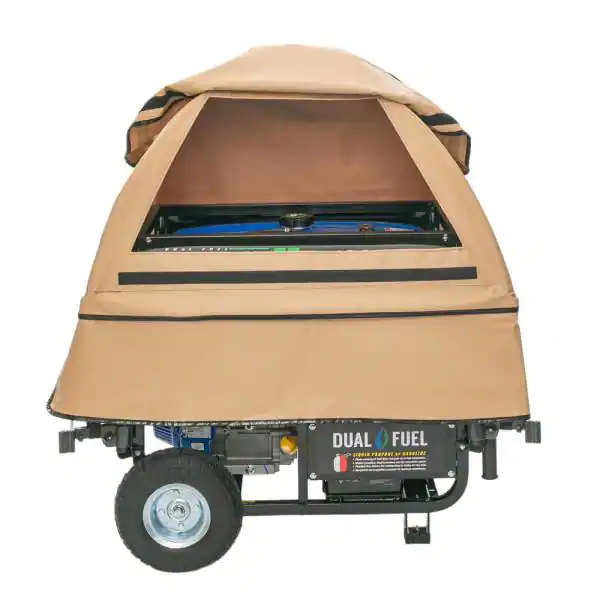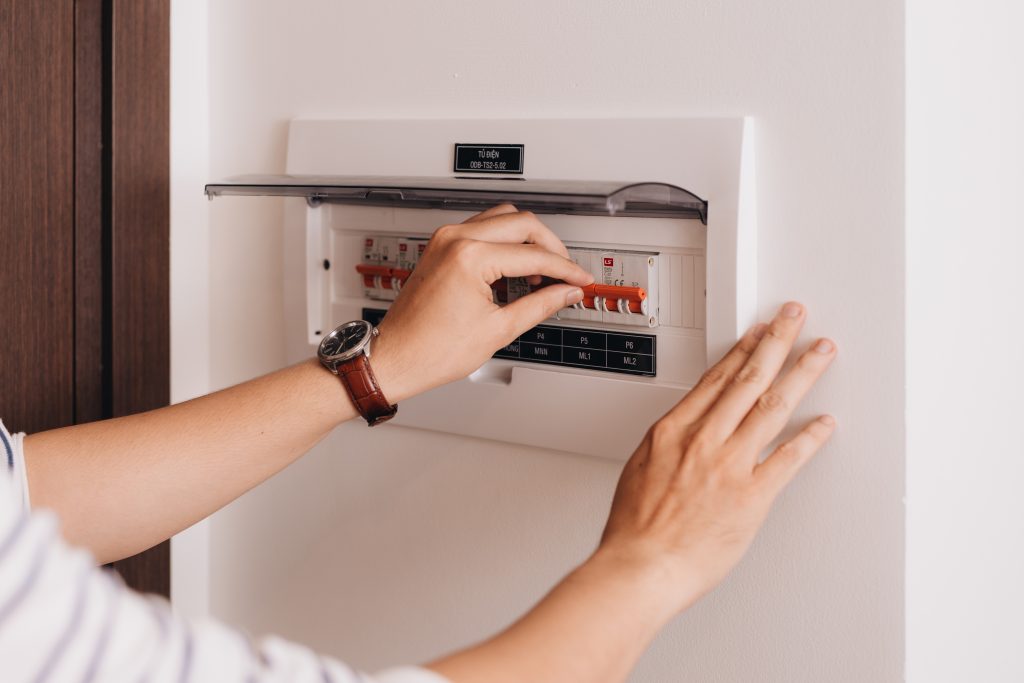If you need to run a generator in the rain, it is necessary to be aware of certain important considerations. Even though different generators may have different safety mechanisms to protect them from a fair level of harsh weather, they are not completely immune to rain. You can learn more about this by referring to Are Generators Waterproof?
The first thing that comes to your mind when thinking about running a generator in the rain is ‘how to cover my generator in the rain?’ All the important things you need to know about this are broken down into fathomable sections as given below. Let’s identify the key factors on how to protect the generator from rain.

How to Protect Your Generator From the Rain?
To identify all the certain safety standards and choose a protective cover, you first need to follow the steps indicated below. It will provide an overall idea of how you need to approach when determining the form of cover needed for your generator.
Consult the User Manual
It is mandatory to consult the owner’s manual before running the generator. It will indicate the important pre-start checklist that the user needs to go through before starting the generator. This will ensure that the conditions are suitable for both the users and the generator itself. In case of choosing a suitable covering method to protect your generator from rain, the user manual will indicate the best solution for the specific model. Through this, you can gain a clear idea of how to protect your generator from the rain.
Select a Precise Location
Knowing where you will be keeping the generator is important in deciding how to cover your generator in the rain. One important thing to consider here is that the generators should not be run indoors. Identifying the location will help you in determining the type and the dimensions of the cover, especially when it comes to a permanent covering.
Check the Generator Connections
Before you work on building the cover, make sure to check the cables and connections of the generator. Special attention should be given to these small details so that the whole unit can be covered safely without leaving out any possible risks of exposure to rain. Once you have gone through all these important concerns, you can then identify the most suitable method to cover them up.
How to Safely Run a Generator in the Rain?
Before you start, you need to know that running a generator in the rain has a higher risk. This is because the contamination of moisture and water with the internal components can impose threats of damage and danger. If you have no other option but to use a generator in wet weather, here are some measures that you can use to ensure safety.
Factors to Consider When Purchasing a Cover for Your Generator
When selecting a proper covering for your generator, the following factors should be checked to ensure that the generator gains complete protection.
- Withstand Elements: This should be a major concern, especially if you are running a portable generator. The generator tent should be able to withstand harsh weather elements, including rain and snow, to ensure a safe operation.
- Well-Ventilated: Another important feature of the generator cover is that it should allow proper air circulation around it. Generators need to have access to the airflow outside to cool down the components inside and prevent overheating. Since most generator tents would hinder this airflow, it may adversely affect the generator.
- Protects Against Moisture: The protective cover of the generator should be able to protect it completely from moisture. Since electrical and electronic components inside the generator are sensitive to moisture, there is a high risk of possible safety hazards. Since generators are not waterproof, choosing an enclosure that protects your generator completely is crucial.
- Portable Cover: When purchasing a protective cover for your generator, you would need to make sure that the cover is portable. This implies especially when running a portable generator. This will ensure that your generator is fit to be run even in rain and wet weather conditions.
Types of Covers

If you are running a portable generator, here are some different types of covers and enclosures that help to run your generator safely during wet conditions.
- Standard Manufacture Covers: Portable generators would usually come with a standard nylon cover. These are designed to suit the specific model of the generator. But these are usually meant to protect the generator during storage rather than from weather conditions. Hence, these covers cannot be used when running a portable generator or even if the generator is still hot.
- Protective Canopy Covers: These are the best covers that you can use to protect your generator while running. It is also the most cost-efficient covering. The cover does not touch the generator die to the elevation provided by poles and hence provides room for adequate airflow. However, this may not be able to withstand the harsh winds that come along with rains. Usually, the canopy covers may have uncovered sides that wouldn’t protect the generator from extreme winds. But still, you can find some canopy covers with walled sides.
- Protective Tent Covers: This is another popular choice by most generator owners. This allows you to ensure the portability of the generator while providing the necessary safety. They do not hinder the airflow and help in refueling. These covers will keep the generator safe from any moisture. You will find them mostly in dome structures with flexible poles and straps bracing down the corners to ensure a safe fit.
- Protective Steel/ Aluminum/ Fiberglass Covers: If you are looking for something firm and rigid, you can choose steel, aluminum, or fiberglass cover to secure your generator. These are mainly used to protect running generators from extreme weather. Since they are positioned well away from the generator, the airflow is not obstructed. In addition to the high level of safety and security, it also provides the advantage of reduction of noise produced by the running generator. You will be able to choose from a wide range of these heavy-duty protective enclosures.
- DIY Protective Enclosures: You can also construct your protective enclosure to protect the generator. However, this should only be done with proper knowledge and professional assistance so as not to damage the generator and also to ensure the safety of lives.
Additional Tips to Run a Generator Safely

In addition to the previously mentioned factors in choosing an ideal generator cover, there are some other factors to follow when running a generator safely.
Never Run a Generator Indoors
The selection of a place to locate your generator is equally important. This is because a generator should not be kept indoors to protect from extreme weather. Generators may emit higher levels of poisonous gases, including carbon monoxide, which is harmful to respiration. Hence, a suitable location outside, at least 10 to 20 feet away from doors and windows, should be selected to place the generator.
Always Use Only One Hand to Touch the Generator
Whenever you are touching the generator, use only one hand to reach the generator. Also, make sure to wear rubber-soled shoes. This is to avoid the creation of a circuit through the body. It is advised to follow these precautions and be extra careful when touching the metallic surfaces and when the floor is wet.
Never Use the Generator in Extreme Weather
Harsh weather conditions such as hurricanes, cyclones, and tornadoes bring speedy winds of over 60mps. Not only the rain but also other heavy objects get carried away towards the generator during this. Hence, it would be ideal not to run the generator in such adverse weather and wait until the condition subsides.
Do not Stand Over the Hot Muffler When Refueling.
Allow the muffler to cool down for at least 10 minutes before refueling. While refueling, you should not stand on the hot muffler side as it can be very dangerous due to possible fire hazards.
Avoid Fuel Clogging
Make sure to shut off the fuel valve so that the generator automatically stops. Through this, you can ensure that the fuel doesn’t clog inside the fuel injectors or carburetors. Use fresh fuel if storing the generator for a long time. Use a fuel stabilizer to help start your generator immediately without problems.
Turn Off the Main Switch Before Starting the Generator
Most generators have a main switch to turn it on and off, which should always be kept turned off before starting or stopping the generator. Make sure to check this condition when plugging or unplugging the cables. This ensures that the load can be taken safely while ensuring that there is no possible danger. It is a precautionary measure to avoid any possible high amperages or voltage spikes.
Avoid Floodwaters
Never place a generator in an area that would flood during rain. Even though there would be no flooding, it is advised to place the generator upon some palette of proper level so that groundwater would not be soaked up.
Use a Transfer Switch
A transfer switch is used to isolate the necessary circuit and get electricity. Therefore, a transfer switch can be used to ensure that power doesn’t back-feed into the power lines. This helps to overcome the risk on line workers and also to ensure that the generator doesn’t get overloaded.
Frequently Asked Questions

How do you cover a generator in the rain while running?
Do not attempt to cover a generator that is running with a storage cover. Plastic sheds are the best option to use as generator covers as they are more durable than light plastic covers. However, they could have overheating issues due to the insulation provided around the generator. If you are planning to create a plastic shed to protect the generator, make sure that it is ventilated properly to allow airflow.
What happens if a generator gets wet?
Wet generators impose a life-threatening risk of electric shocks and electrocution. This may happen if someone tries to plug in or unplug items when the generator is wet. Hence, wet generators should be allowed to dry completely before using.
Is it safe to run a generator during a thunderstorm?
Generators could be very dangerous if not used properly, especially during adverse weather. Most people would assume it is a good idea to keep the generator indoors to protect it from rain. However, this may bring fatal results as the harmful gases emitted during combustion could even cause death when inhaled. If you are unable to provide a safe environment for the generator to protect from rain, it is advised to refrain from running the generator until the wet weather passes by.
How far away from the house does a generator need to be?
The minimum distance at which a generator should be placed away from a house is 20 feet. The engine exhaust should be directed away from the doors and windows. This is to ensure that toxic fumes emitted from combustion do not get indoors. Furthermore, generators should never be run indoors, including on covered porches and garages.
How much ventilation does a generator need?
It is necessary to have adequate ventilation around the generator to ensure proper function without overheating. It is recommended to have a clear space of 3 to 4 feet on all sides and above to allow enough airflow to cool the interiors.
Conclusion
There are many obstructions if you need to run a generator in the rain. However, you can enjoy the convenience of generating power if you follow the precautionary measures described above. Purchase the correct generator tent and protect your generator from the adverse effects of rain and moisture. Make sure to go through the manual and identify the specific wet weather cover that suits the model and size of your generator. From what other factors should you protect your generator for optimal use? Learn more here from the discussion Are Generators EMP Proof?